Hirsch:

Reinman:

Reinman:
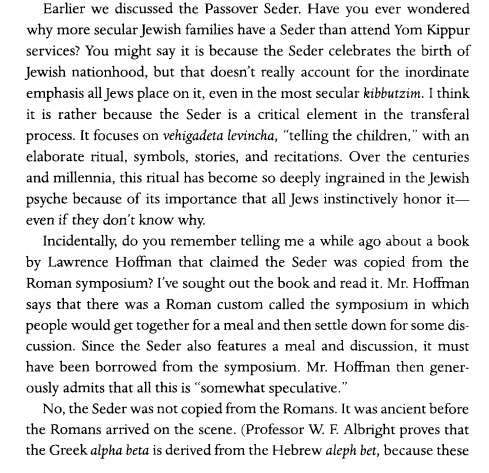

It should not be surprising that the awareness of many similarities between the forms of the Passover seder and the Symposium seder can be found in Christian literature for centuries. After all, the seder plays an important role in the New Testament and the classical literature where it's form is described was on the reading lists of those scholars. Note: similarity means . . . similarity. Naturally the question is not as simple and simple-minded as either Hirsch or Reinman presents it. But I'm more interested in the afikomen (see Balashon).
I can't resist an aside regarding Reinman's distortion (or misunderstanding) of Albright. Although I don't know exactly where in Albright's writings he refers, given that the book can't be bothered with providing sources, let's assume that at least this position is articulated in his most famous, most popular book From the Stone Age to Christianity - Monotheism and the Historical Process, which you can already tell from the title that he probably doesn't support Reinman's positions. In this book, the alphabet to which he refers is called "the North-Semitic (Phoenician) alphabet, and in other cases "Canaanite". He writes that the Phoenician script is descended from the "proto-Cananite," and "That this alphabet was known to nomads as well as to sedentary Canaanites is certain from the proto-Sinaitic inscriptions, dating from between 1800 and 1600 B.C." It's not as if he doesn't know how to write the word "Israelite" (or "pre-Mosaic Hebrews," as in "the pre-Mosaic Hebrews had also been accustomed accustomed to thinking of their chief god, the storm-god Shaddai, as standing on a bull, and the pre-Israelite Hebrews of central Palestine almost certainly shared ideas of this kind with their Canaanite neighbors, who portrayed Baal in the same way.")
In short, Albright is not the source of the centuries-old observation that "alpha beta gamma" are not Greek words, but they are Semitic words. It is also known from the Greeks themselves that their alphabet comes from the Phoenician; a mythical Phoenician (ie, Northern Canaanite) named Kadmus is supposed to have delivered them their alphabet. However, see below for a source which is נאמן יותר ממאה עדים:
In Rabbi Elijah Levita (Bachur)'s Tishby we find the following entry for afikomen, where we see that he is surprised that the obvious Greekness of the word eluded earlier scholars in favor of a far-fetched notaryekon:
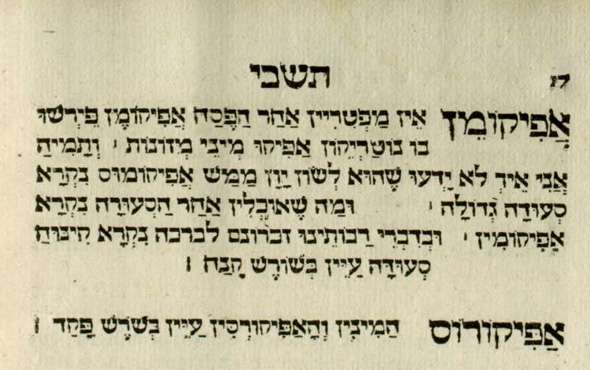
In case anyone is wondering how reliable Levita is, in the Peri Megadim's opinion התשבי נאמן יותר ממאה עדים:
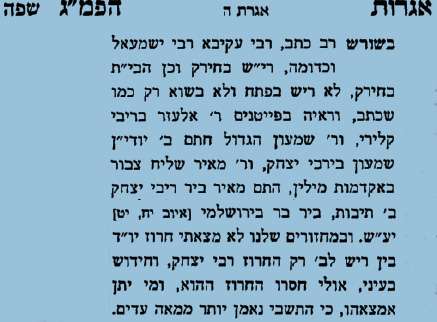
Below is a very interesting passage in Isaac Baer Levinsohn's Efes Damim (1837) in which he refutes the blood accusation against the Jews. The book takes the form of a dialog between a rabbi (Abraham ibn Maymun) and a Greek Orthodox patriarch (Simeias) in Jerusalem. Here is an extensive passage in the original Hebrew and in Louis Loewe's English translation of 1841 (the English translation was commissioned by Sir Moses Montefiore on the occasion of the 1840 Damascus Blood Libel):

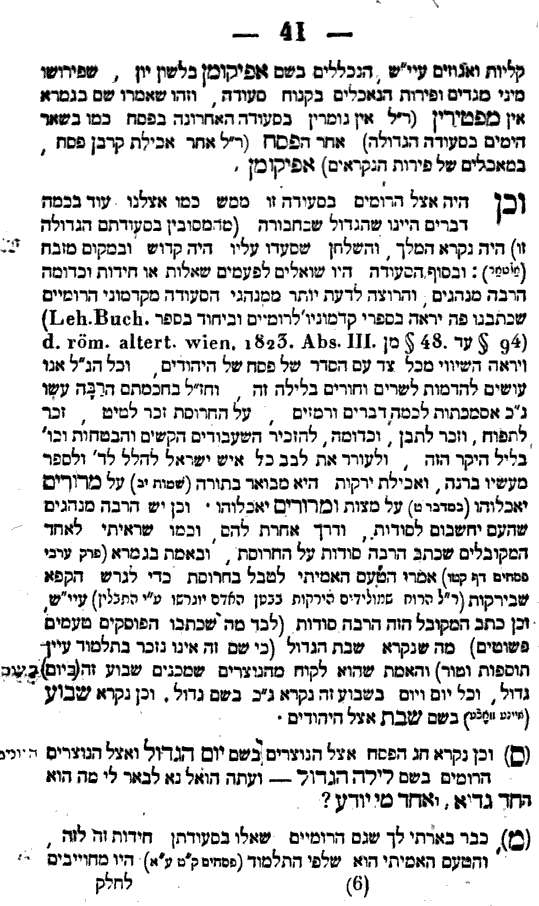
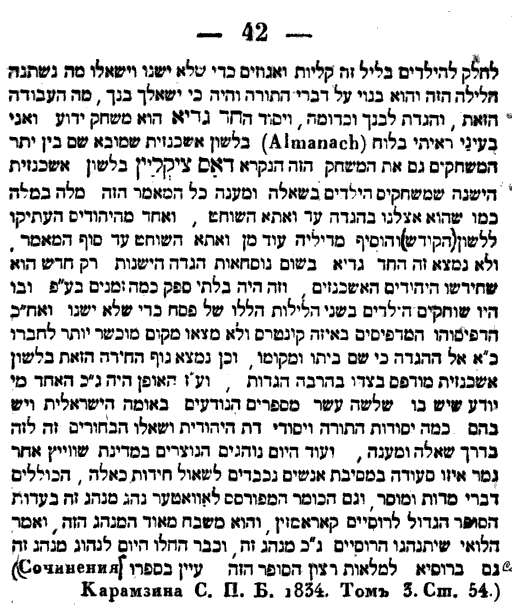
Efes Dammim in English 1841:

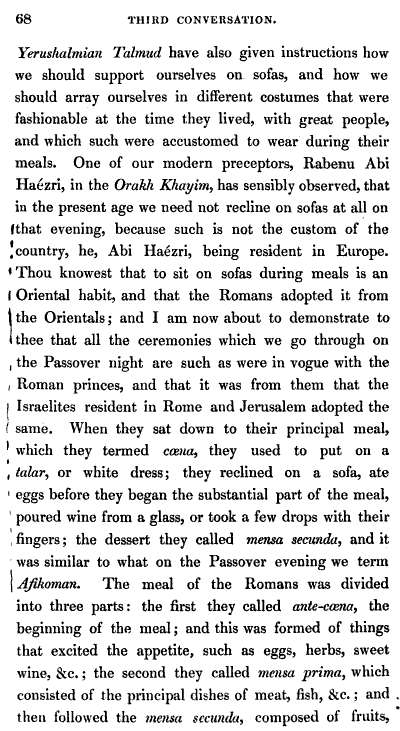
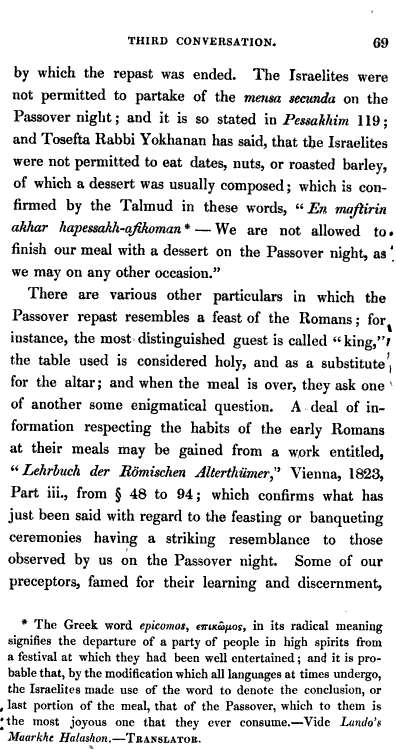

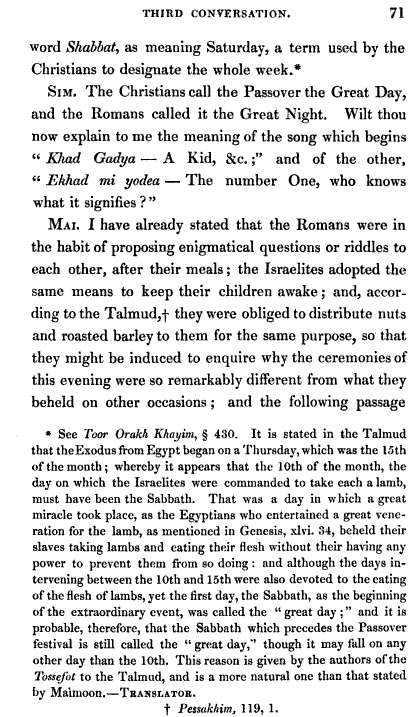
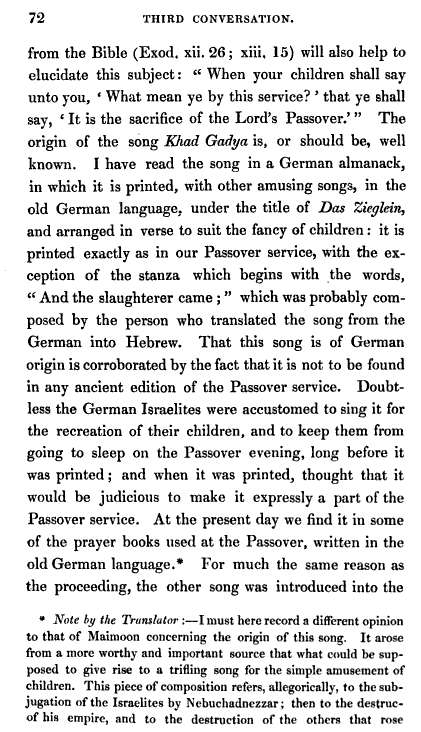
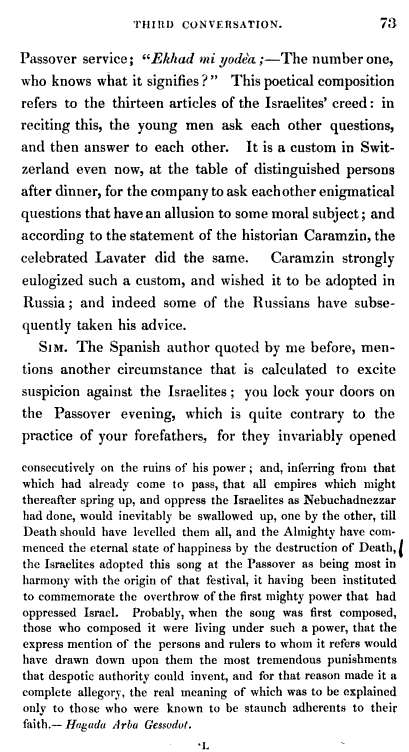
For completion, below is the 1819 entry for afikomen in Landau's edition of the Arukh which Loewe refers to in a footnote (he calls him "Lando"), followed by Alexander Kohut in the Arukh Hashalem, where he is sure that it is a Persian word:
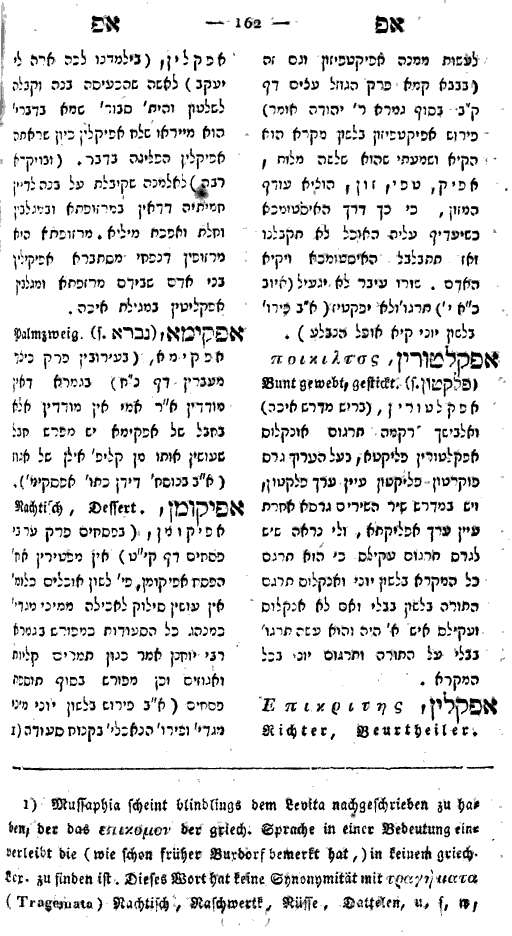
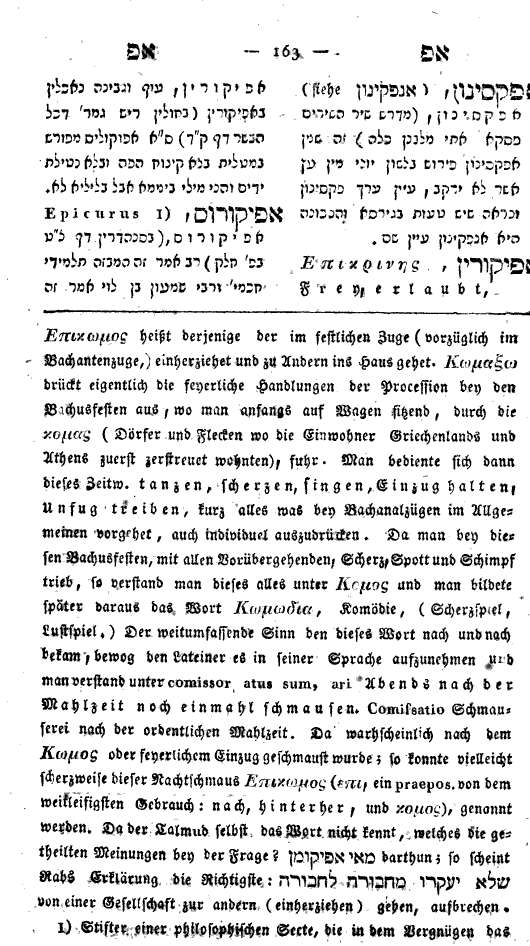
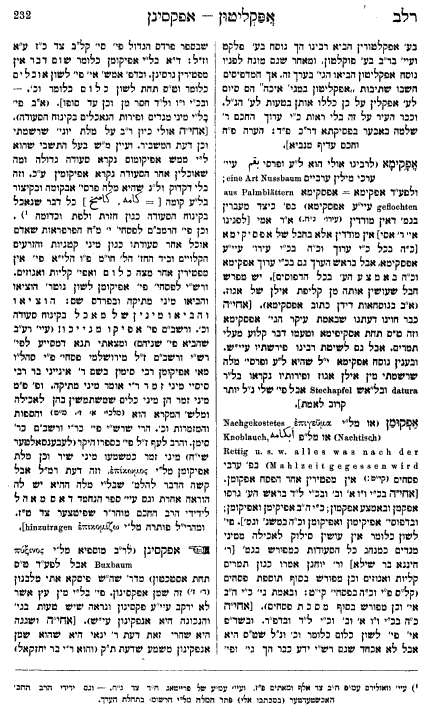





and see - http://hebrewbooks.org/pdfpager.aspx?req=23541&st=&pgnum=67&hilite=
ReplyDelete(H. learns it refers to dessert and is related to the word epicure (I think))
some funny things have come from hoffman's pen (or editorship), but it's funny how he dismisses as "hoffman, whoever that it is"
ReplyDeleteas to why more secular jews have a seder than go to shul on yom kippur, it's pretty simple:
a) it is family oriented
b) it is a lot more fun.
And brit milah?
ReplyDeletecircumcision has (percieved) medical benefit and a majority of american parents still circumcise their kids. against this backdrop, i'm not sure how much one can ascribe jewish-influenced motives to secular jewish circumcision.
ReplyDelete(and of those who do it, for how many is it ritual circumcision by a mohel as opposed to a hospital procedure by a stam doctor [jewish or not]?)
what happened to my last comment? hopefully it will come back.
ReplyDeletei'm actually wondering what are the of circumcision rates among secular (or even non-ortho) jews. and how many who do arrange it as a ritual rather as a medical procedure.
i checked njop, but this was not included on the questionaire.
also berit milah is not elective as seder and fasting are. (i.e., the child doesn't have a choice.) i'd bet that if it were elective, rates would fall dramatically(across the board, not just among "secular")
ReplyDeleteI have much to add to this great post. For now see R Akiva Eiger who brings down this Tishbi in his notes to the Mishna in pesachim.
ReplyDeleteFor another discussion of R Dovid Zvi Hoffman on this word see http://www.hebrewbooks.org/pdfpager.aspx?req=29650&st=&pgnum=7&hilite=
ReplyDeleteI'm actually quite impressed that Reinman would be so ignorant as to really not know about the Hellenistic Origins of the seder, and knee-jerkingly respond that they stole it from us - and then, when proven wrong, agree to have his stupid response printed in a book.
ReplyDeleteFRED:
ReplyDeleteyesterday's הפטרה made me think of the ברית מילה comment
מועדים לשמחה
Have you actually seen an old example of this "Das Zeiglin", the original source of the Chad Gadya? can you attach a copy? Doing so would be on a par, for most people, with exposing the teetotum as the original source of the dreidel.
ReplyDeleteDF
When I get the chance later, although it's not as dramatic as implied here. Petting zoos await.
ReplyDeleteWhat are the odds that anyone will be interested after Pesach?
ReplyDelete>as to why more secular jews have a seder than go to shul on yom kippur, it's pretty simple:
ReplyDeletea) it is family oriented
b) it is a lot more fun.
the most recent studies show that between 75%-85% of Jews in Israel fast on Yom Kippur. The country itself grinds to a complete halt and whole cities have only the traffic of Ambulances zooming around (this was more pronounced when I was a child and the more secular cities such as Haifa and Tel Aviv now have a bit of non-medical traffic but overall my description is still accurate).
>against this backdrop, i'm not sure how much one can ascribe jewish-influenced motives to secular jewish circumcision.
If you ask most "secular" Jews why they do a Brit Mila to their sons, then the most common answer you will hear is not one about the medical advantages but rather simply "because we are Jewish" And the vast majority use a mohel (some want to use a mohel/physician because they have misplaced safety concerned but such a person is almost always a mohel certified by the misrad haBriut AND the rabbanut). We recently had a daughter born in a local hospital where the majority of the women in the maternity ward were not religious and since I look the part, I was the address for many questions regarding mila and mohel recomendations. I can tell you that mila is still a powerful symbol for Jews of all stripes here in Israel and that based on my experience, you comment comes off as a bit cynical.
CHARDAL:
ReplyDeletei understand your point regarding the stat of israelis fasting, but what does it have to do with the comparison of seder vs. attending yom kippur services?
regarding berit milah, i see you are talking about israel and i was referring to america. apples and oranges.
and mazal tov
Reading Reinman is kind of embarrassing to me, as an Orthodox Jew. I remember R' Leiman saying that Reinman "wins" only because Hirsch is even a bigger ignoramus than him. The Romans copied from the Jews. Right.
ReplyDeleteNeedless to say, the meanings of "Aleph Bet" etc. have nothing to do with what it says in the Gemara.
For example, "aleph" presumably means ox, which is clear based on the shape of the letter in the old script, especially in earlier variants. Aleph in it splural form אלפים also meant oxen in Biblical Hebrew, but its rare (see eg Proverbs 14.4). Perhaps it wasn't rare in Canaanite or Phoenician, or at least an earlier Hebrew. But the point is that it seems to preserve an early form.
ReplyDelete>but what does it have to do with the comparison of seder vs. attending yom kippur services?
ReplyDeleteI thought your point was that the seder was more popular because it is more comfortable/easy. So I was doing a sort of kal vaChomer regarding fasting.
My main point is that some mitzvot are also great symbols of Jewish identity, and that b"H, at least in Israel, most Jews, religious or not, still want to be ... well ... Jewish. So the most powerful symbols of Jewishness such as milah, seder, fasting on YK, and for that matter Friday night dinner/candle lighting are still VERY widespread here.
Hirhurim weighs in on the topic of the symposium:
ReplyDeletehttp://torahmusings.com/2012/04/the-seder-and-the-symposium/
"he is surprised that the obvious Greekness of the word eluded earlier scholars in favor of a far-fetched notaryekon"
ReplyDeletehow could it be that the master of words did not use the term "Backronym".